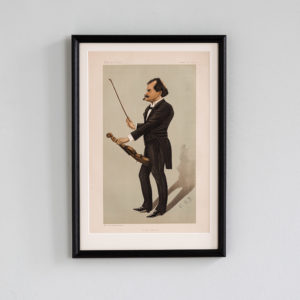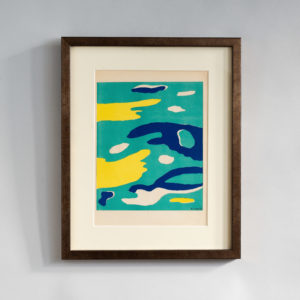2 items found
Page 1 of 1
-

The Intermezzo,
£220The Intermezzo,
Framed Chromolithograph by WH (Wallace Hester) picturing the Italian composer Pietro Mascagni. In 1890 Mascagni delighted the Italian nation with his exquisite opera 'Cavalleria Rusticana'. Written in response to a competition for young composers in 1888, Mascagni had not actually intended to finally submit his work as he doubted it's quality. The composer's wife found the draft hidden in a draw and, seeing it's worth, illicitly submitted it on his behalf on the final day of the competition. The opera was an instant and unqualified success, earning Mascagni 40 curtain calls on the first night as well as first prize in the contest and receiving a standing ovation such as the Teatro Constanzo in Rome had not seen 'in many years'. The 'intermezzo' from Cavaleria Rusticana was particularly noted for its beauty and charm and has become famous in it's own right, appearing in the soundtrack of the Martin Scorsese film 'Raging Bull'.£220 -

Eduard Strauss,
£170Eduard Strauss,
Framed Chromolithograph signed EBN depicting the Austrian composer and conductor Eduard Strauss, brother of Johann II and Josef Strauss.£170
Featured Items
-

The Four Elements, Water by Fernand Leger, Verve Vol. 1 / No. 1.
£600The Four Elements, Water by Fernand Leger, Verve Vol. 1 / No. 1.
The Verve Review was a purposefully luxurious. It ran from 1937 to 1960, but with only 38 editions available, due to the high degree of design and editorial work dedicated to each issue. Each edition contained unique lithographic prints, commissioned by the editor, and each cover a double-page lithograph elaborated by one of the artists contained within. It was the brainchild of its editor Stratis Eleftheriades, a Greek National who moved to Paris in the early thirties to take part in the growing Modernist movement, writing under the name of Teriade.£600 -

Printemps by Marc Chagall, Verve Vol. 1 / No. 3.
£800Printemps by Marc Chagall, Verve Vol. 1 / No. 3.
The Verve Review was a purposefully luxurious. It ran from 1937 to 1960, but with only 38 editions available, due to the high degree of design and editorial work dedicated to each issue. Each edition contained unique lithographic prints, commissioned by the editor, and each cover a double-page lithograph elaborated by one of the artists contained within. It was the brainchild of its editor Stratis Eleftheriades, a Greek National who moved to Paris in the early thirties to take part in the growing Modernist movement, writing under the name of Teriade.£800 -

Head of a Girl by George Rouault, Verve Vol 2 / No. 5-6.
£800Head of a Girl by George Rouault, Verve Vol 2 / No. 5-6.
The Verve Review was a purposefully luxurious. It ran from 1937 to 1960, but with only 38 editions available, due to the high degree of design and editorial work dedicated to each issue. Each edition contained unique lithographic prints, commissioned by the editor, and each cover a double-page lithograph elaborated by one of the artists contained within. It was the brainchild of its editor Stratis Eleftheriades, a Greek National who moved to Paris in the early thirties to take part in the growing Modernist movement, writing under the name of Teriade.£800 -

Portraits Part I by Constantin Guys, Verve Vol 2 / No. 5-6.
£500Portraits Part I by Constantin Guys, Verve Vol 2 / No. 5-6.
The Verve Review was a purposefully luxurious. It ran from 1937 to 1960, but with only 38 editions available, due to the high degree of design and editorial work dedicated to each issue. Each edition contained unique lithographic prints, commissioned by the editor, and each cover a double-page lithograph elaborated by one of the artists contained within. It was the brainchild of its editor Stratis Eleftheriades, a Greek National who moved to Paris in the early thirties to take part in the growing Modernist movement, writing under the name of Teriade.£500
